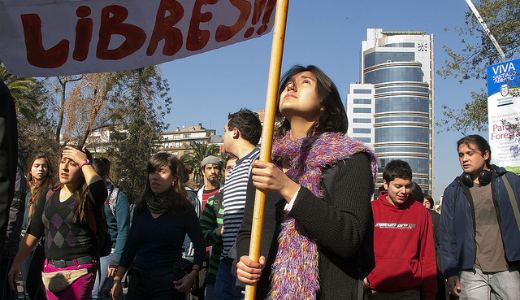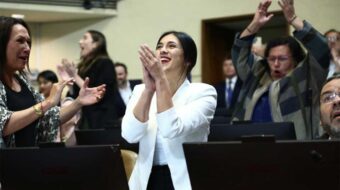
A wave of outrage at market, banker rule circles the world. Protesters target wage and pension cuts in Europe, money power in the United States, and young people left behind everywhere. In Europe, unemployment for those under 25 averages 25 percent, in Spain 43.6 percent. Huge British and Italian student demonstrations protested tuition hikes last year. Recent U.S. college graduates joining the Occupy Wall Street movement tell of poor job prospects and heavy debt loads.
Chilean students are giving lessons to the global movement. Building over five months and relying upon collective decision making, students there have moved from immediate demands to an overall critique of Chile’s dominant political-economic system, a legacy of the Pinochet dictatorship. They’ve created alliances with labor unions, indigenous groups, and social movements.
Hundreds of thousands demonstrated repeatedly over weeks, and with schools occupied and absenteeism on the rise, students carried out a general strike Aug. 25, in collaboration with labor. The government of right-wing president Sebastian Piñera began negotiations with student leaders. Issues students put on the table included free, high quality education for all, national rather than local control of schools, and education as a matter of right, not money.
University education in Chile is the most privatized in Latin America. Families and students cover almost 85 percent of charges levied for attendance at Chilean universities. Tuition and student debt loads are spectacularly high.
Negotiations failed, serving only to provoke minor criticism of student leaders as compromisers and to offer brief hope to students worried about losing scholarships and a year of school credits. The student movement responded by returning to the streets nationwide Oct. 7, only to be met with police repression; 250 were arrested in Santiago. The government is considering new laws criminalizing student demonstrators. Partnering with the main Chilean labor federation, students launched a general strike on Oct. 18-19.
For several months, they’ve called for constitutional changes and the abolition of an electoral system that pushes political parties into two coalitions. During the talks, student negotiators returned to larger issues affecting all of society. Education for all would be funded through tax reforms and copper industry nationalization. In that vein, they joined with the Association of Chilean Teachers to organize a non-binding national plebiscite.
On Oct. 7-9, 90 percent of the 1.5 million people taking part answered “yes” to four questions: Do you agree the state should guarantee a free, quality education? Do you agree the government should take back control of schools? Do you agree with prohibiting public funds used to support educational profiteering? Do you agree with the use of binding plebiscites to resolve fundamental national problems?
Student leader Giorgio Jackson highlights the students’ new role as protagonists. Writing for Le Monde Diplomatique, Jackson says the “central axis is the inequality dominating in Chile that enabled us to arouse latent discontent.” He explains: “From initial demands of access to education, its financing, and democratization, we have arrived at a clear citizens’ demand for constitutional changes…the process deepened and together with citizens we began to deal with basic problems. We didn’t enter into a constitutional discussion at first…That required an educational process [and] that’s perhaps our major success.”
Chilean students are setting an example in Latin America. All over Colombia Oct. 12 some half million students, joined by teachers, marched in support of public education. They faced murderous police violence. For whatever reason, Colombian victims of poverty, displacement, and political repression have yet to manage such an outpouring.
Students in the Dominican Republic, joined by teachers’ groups and others, demonstrated repeatedly in October against a new national budget spending less than two percent of the gross national product on public education. The law requires expenditure of at least four percent.
Speaking recently of the Chilean students, Bolivian Vice President Álvaro García Linera affirmed that, “Their demand of education as a collective right… brings us into the old Marxist discussion of usage value versus exchange value. Does education have value as use, something required by humans to satisfy necessities? Young people fighting for education…are struggling for a new universe.”
Whatever the students’ aspirations may be, and their example, the nationwide mobilization Oct. 18-19 provoked the state’s heavy hand. Prior to an outpouring of at least 200,000 demonstrators – the police said 20,000 – President Piñera had announced resort to the State Security Law dating from the Pinochet dictatorship. Police waded into crowds with water cannons and tear gas, utterly failing, said student leaders, to distinguish between masses of peaceful and locally authorized protesters and bands of hooded thugs. Ultimately, 373 marchers were arrested and thirty or so wounded.
Additionally, the government recently announced the draft of 57,793 18-year-olds for obligatory military service. From that number, far in excess of the usual call-up, the army would select 11,340 new soldiers. The intention, say critics, is to intimidate and to cut into the ranks of student protesters.
Photo: Student demonstration in Chile. Rafael Edwards // CC 2.0












Comments